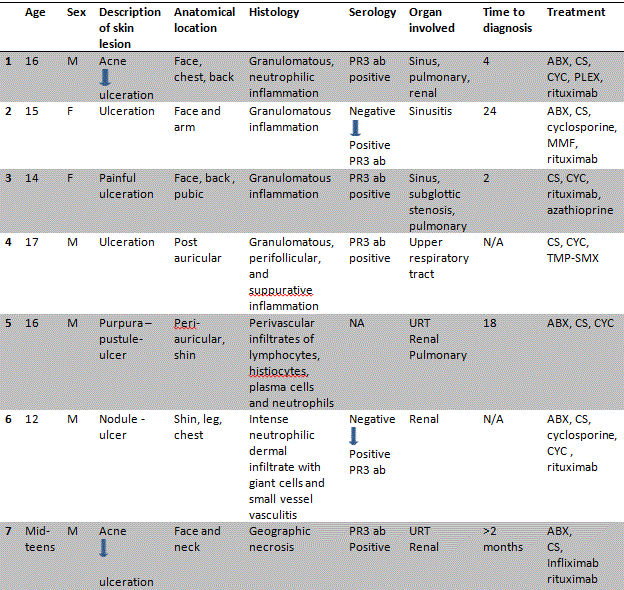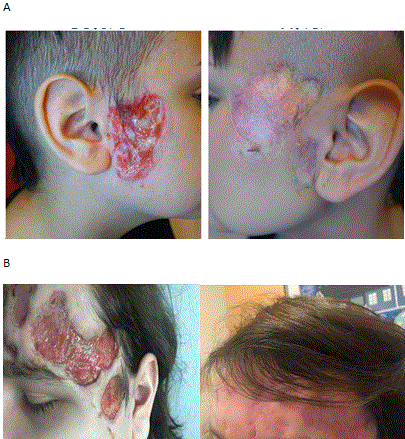Session Information
The 2020 Pediatric Rheumatology Symposium, originally scheduled for April 29 – May 2, was postponed due to COVID-19; therefore, abstracts were not presented as scheduled.
Date: Friday, May 1, 2020
Title: Poster Session 2
Session Type: ACR Abstract Session
Session Time: 5:00PM-6:00PM
Background/Purpose: GPA is a form of anti-neutrophilic cytoplasmic antibody vasculitis affecting small to medium sized vessels and involves most commonly the kidneys and the respiratory tract. Skin involvement can be seen in up to 50% of children with GPA, and is the presenting symptom in 7.7%. Pyoderma gangrenosum (PG) is a rapidly progressive, sterile ulcerating neutrophilic dermatosis which most frequently affects the lower extremities. PG-like ulceration rarely is described as a skin manifestation in GPA and very few cases have been reported previously in children. Our aim was to identify and characterize GPA-related PG.
Methods: A literature review through electronic database using the following keywords – “skin ulcer”, “pyoderma gangrenosum”, “granulomatosis with polyangiitis”, “Wegener’s granulomatosis” was conducted. Four pediatric GPA patients who had PG-like ulcerative lesions were identified. We assessed the clinical characteristics, serology, and response to treatment of these 4 cases, in addition to our 3 newly diagnosed cases. We compared the distribution of PG-like ulcerative skin lesions in the 7 GPA patients with PG to those of children with PG and no GPA.
Results: Clinical characteristics of the 7 cases are presented in table I. The mean age at first symptom is 15 years with M:F ratio of 5:2. Five children had PG-like ulceration as their initial presentation; additional symptoms eventually led to their GPA diagnosis a mean of 10 months later (range 3 to 24 months). In 2 cases, proteinase 3 (PR3) was negative when first tested, but converted to positive on repeat evaluation when systemic symptoms emerged. All patients eventually had a positive PR3. The ulcerative PG-like lesions initially manifested as purpura, nodule or acne in 4 patients. All 7 patients had primarily facial lesions, compared to only 3.9% of 170 pediatric patients with PG which are described in the literature. Our patients also had chest and back involvement. Four of the seven skin biopsies showed granulomatous inflammation, however 2 of these were noted only on reassessment by dermatopathologists after the diagnosis of GPA was made. Six of seven patients had upper respiratory tract involvement. Three had pulmonary and 4 had renal involvement. None of the 7 patients responded to treatment with antibiotics or medications commonly used to manage PG, including corticosteroids and cyclosporine. The five patients who received rituximab all had excellent responses, including one who had failed cyclophosphamide. Pre- and post-treatment images of patients 1 and 2 can be seen in Fig I. Histology of an ulcerative skin lesion of patient 2 can be seen in Fig II.
Conclusion: PG-like ulceration is a unique and rare presentation of GPA which sometimes precedes the classic systemic GPA symptoms. The predominance of facial ulcer, granulomatous inflammation on skin biopsy and lack of response to PG treatments are more common in GPA-associated PG. Our review suggests that treatment of GPA with rituximab may be needed to improve the skin lesions. Recognizing that PG-like ulcerations can occur in GPA may result in a timely diagnosis and appropriate treatment which can help improve prognosis.
To cite this abstract in AMA style:
Semo R, Tal R, Dallos T, Harel L, Plank L, Wagner-Weiner L. Pyoderma Gangrenosum Ulceration as a Presenting Feature of Pediatric Granulomatosis with Polyangiitis (GPA) [abstract]. Arthritis Rheumatol. 2020; 72 (suppl 4). https://acrabstracts.org/abstract/pyoderma-gangrenosum-ulceration-as-a-presenting-feature-of-pediatric-granulomatosis-with-polyangiitis-gpa/. Accessed .« Back to 2020 Pediatric Rheumatology Symposium
ACR Meeting Abstracts - https://acrabstracts.org/abstract/pyoderma-gangrenosum-ulceration-as-a-presenting-feature-of-pediatric-granulomatosis-with-polyangiitis-gpa/


